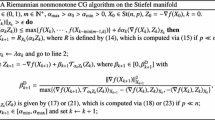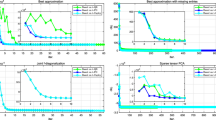Abstract
The quasi-Newton methods on Riemannian manifolds proposed thus far do not appear to lend themselves to satisfactory convergence analyses unless they resort to an isometric vector transport. This prompts us to propose a computationally tractable isometric vector transport on the Stiefel manifold of orthonormal p-frames in \(\mathbb {R}^n\). Specifically, it requires \(O(np^2)\) flops, which is considerably less expensive than existing alternatives in the frequently encountered case where \(n\gg p\). We then build on this result to also propose computationally tractable isometric vector transports on other manifolds, namely the Grassmann manifold, the fixed-rank manifold, and the positive-semidefinite fixed-rank manifold. In the process, we also propose a convenient way to represent tangent vectors to these manifolds as elements of \(\mathbb {R}^d\), where d is the dimension of the manifold. We call this an “intrinsic” representation, as opposed to “extrinsic” representations as elements of \(\mathbb {R}^w\), where w is the dimension of the embedding space. Finally, we demonstrate the performance of the proposed isometric vector transport in the context of a Riemannian quasi-Newton method applied to minimizing the Brockett cost function.

Similar content being viewed by others
Notes
Throughout this paper, the computational complexity is measured by flop counts. A flop is a floating point operation [12, Section 1.2.4].
It should be noted that for those Z such that \(\phi (Z)\) is nonsmooth, there always exists a permutation matrix P, which is usually obtained by row pivoting QR decomposition, such that \(\phi (PZ)\) is smooth. Therefore, one can define \(\tilde{\phi }(Z) = P^T \phi (PZ)\), which is also smooth and satisfies \(\tilde{\phi }(Z) = \begin{bmatrix} Z&Z_\perp \end{bmatrix}\).
For gradient based methods, \(\mathrm {E2D}\) is always applied before \(\mathrm {D2E}\) since the gradient at a new iterate is computed almost immediately after the new iterate is obtained, and \(\mathrm {E2D}\) need be invoked to obtain the intrinsic representation of the gradient.
Note that \(Alg1(X, Z) = Alg1(X, P_X (Z))\), where \(X \in {{\mathrm{\mathrm {St}}}}(p, n)\) and \(Alg1: ({{\mathrm{\mathrm {St}}}}(p, n), \mathbb {R}^{n \times p}) \rightarrow \mathbb {R}^{np - p(p+1)/2}\) is the function defined by Algorithm 1.
References
Anderson, E., Bai, Z., Bischof, C., Blackford, L., Demmel, J., Dongarra, J., Du Croz, J., Greenbaum, A., Hammarling, S., McKenney, A., Sorensen, D.: LAPACK Users’ Guide. Society for Industrial and Applied Mathematics, 3rd edn (1999)
Absil, P.-A., Baker, C.G., Gallivan, K.A.: Trust-region methods on Riemannian manifolds. Found. Comput. Math. 7(3), 303–330 (2007)
Adler, R.L., Dedieu, J.-P., Margulies, J.Y.: Newton’s method on Riemannian manifolds and a geometric model for the human spine. IMA J. Numer. Anal. 22(3), 359–390 (2002)
Absil, P.-A., Mahony, R., Sepulchre, R.: Optimization algorithms on matrix manifolds. Princeton University Press, Princeton, NJ (2008)
Absil, P.-A., Oseledets, I.V.: Low-rank retractions: a survey and new results. Comput. Optim. Appl. 62(1), 5–29 (2015)
Afsari, B., Tron, R., Vidal, R.: On the convergence of gradient descent for finding the Riemannian center of mass. SIAM J. Control Optim. 51(3), 2230–2260 (2013). arXiv:1201.0925v1
Boumal, N., Absil, P.A.: RTRMC: A Riemannian trust-region method for low-rank matrix completion. Adv. Neural Inf. Process. Syst. 24(NIPS), 406–414 (2011)
Bini, D.A., Iannazzo, B.: Computing the Karcher mean of symmetric positive definite matrices. Linear Algebra Appl. 438(4), 1700–1710 (2013). doi:10.1016/j.laa.2011.08.052
Boothby, W.M.: An introduction to differentiable manifolds and Riemannian geometry, 2nd edn. Academic Press, USA (1986)
Dai, W., Kerman, E., Milenkovic, O.: A geometric approach to low-rank matrix completion. IEEE Trans. Inf. Theory 58(1), 237–247 (2012). arXiv:1006.2086v1
Edelman, A., Arias, T.A., Smith, S.T.: The geometry of algorithms with orthogonality constraints. SIAM J. Matrix Anal. Appl. 20(2), 303–353 (1998). doi:10.1137/S0895479895290954
Golub, G.H., Van Loan, C.F.: Matrix computations. Johns Hopkins Studies in the Mathematical Sciences, 3rd edn. Johns Hopkins University Press, USA (1996)
Goemans, M.X., Williamson, D.P.: Improved approximation algorithms for maximum cut and satisfiability problems using semidefinite programming. J. ACM 42(6), 1115–1145 (1995)
Huang, W., Absil, P.-A., Gallivan, K.A.: A Riemannian symmetric rank-one trust-region method. Math. Program. 150(2), 179–216 (2015)
Huang, W., Absil, P.A., Gallivan, K.A.: A Riemannian BFGS method for nonconvex optimization problems. Lect. Notes Comput. Sci. Eng. (2016) (to appear)
Huang, W., Gallivan, K.A., Absil, P.A.: A Broyden Class of Quasi-Newton Methods for Riemannian Optimization. SIAM J. Optim. 25(3), 1660–1685 (2015)
Huang, W., Gallivan, K.A., Srivastava, A., Absil, P.A.: Riemannian optimization for registration of curves in elastic shape analysis. J. Math. Imaging Vision 54(3), 320–343 (2015). doi:10.1007/s10851-015-0606-8
Huang, W., Gallivan, K.A., Zhang, X.: Solving phaselift by low rank Riemannian optimization methods. In: Proceedings of the International Conference on Computational Science (ICCS2016) (2016) (accepted)
Kleinsteuber, M., Shen, H.: Blind source separation with compressively sensed linear mixtures. IEEE Signal Process. Lett. 19(2), 107–110 (2012). arXiv:1110.2593v1
Lee, J.M.: Introduction to smooth manifolds, vol. 36 of Graduate Texts in Mathematics. Springer, New York (2011). doi:10.1016/B978-0-12-387667-6.00013-0
Mishra, B., Meyer, G., Sepulchre, R.: Low-rank optimization for distance matrix completion. In: Proceeding of 50th IEEE Conference on Decision and Control and European Control Conference, pp. 4455–4460 (2011). doi:10.1109/CDC.2011.6160810
Nocedal, J., Wright, S.J.: Numerical Optimization, 2nd ed. Springer, New York (2006)
Qi, C., Gallivan, K.A., Absil, P.-A.: Riemannian BFGS algorithm with applications. Recent Advances in Optimization and its Applications in Engineering, pp. 183–192 (2010)
Ring, W., Wirth, B.: Optimization methods on Riemannian manifolds and their application to shape space. SIAM J. Optim. 22(2), 596–627 (2012). doi:10.1137/11082885X
Selvan, S.E., Amato, U., Gallivan, K.A., Qi, C.: Descent algorithms on oblique manifold for source-adaptive ICA contrast. IEEE Trans. Neural Netw. Learn. Syst. 23(12), 1930–1947 (2012)
Sander, O.: Geodesic finite elements for Cosserat rods. Int. J. Numer. Meth. Eng. 82(13), 1645–1670 (2010). doi:10.1002/nme.2814
Sato, H.: A Dai-Yuan-type Riemannian conjugate gradient method with the weak Wolfe conditions. Comput. Optim. Appl. (2015) (to appear)
Sato, H., Iwai, T.: A new, globally convergent Riemannian conjugate gradient method. Optimization 64(4), 1011–1031 (2015)
Turaga, P., Veeraraghavan, A., Srivastava, A., Chellappa, R.: Statistical computations on Grassmann and Stiefel manifolds for image and video-based recognition. IEEE Trans. Pattern Anal. Mach. Intell. 33(11), 2273–2286 (2011). doi:10.1109/TPAMI.2011.52
Vandereycken, B.: Low-rank matrix completion by Riemannian optimization–extended version. SIAM J. Optim. 23(2), 1214–1236 (2013)
Vandereycken, B., Absil, P.A., Vandewalle, S.: Embedded geometry of the set of symmetric positive semidefinite matrices of fixed rank. In: Proceedings of the IEEE 15th Workshop on Statistical Signal Processing, pp. 389–392 (2009)
Author information
Authors and Affiliations
Corresponding author
Additional information
This paper presents research results of the Belgian Network DYSCO (Dynamical Systems, Control, and Optimization), funded by the Interuniversity Attraction Poles Programme initiated by the Belgian Science Policy Office. This work was supported by Grant FNRS PDR T.0173.13.
Rights and permissions
About this article
Cite this article
Huang, W., Absil, PA. & Gallivan, K.A. Intrinsic representation of tangent vectors and vector transports on matrix manifolds. Numer. Math. 136, 523–543 (2017). https://doi.org/10.1007/s00211-016-0848-4
Received:
Revised:
Published:
Issue Date:
DOI: https://doi.org/10.1007/s00211-016-0848-4




